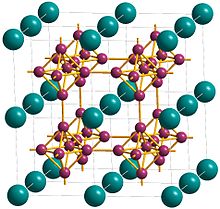Praseodymium hexaboride

| |
| Names | |
|---|---|
| Other names
Praseodymium boride
| |
| Identifiers | |
3D model (JSmol)
|
|
| ChemSpider | |
| ECHA InfoCard | 100.031.382 |
| EC Number |
|
PubChem CID
|
|
CompTox Dashboard (EPA)
|
|
| |
| |
| Properties | |
| PrB6 | |
| Molar mass | 205.77 g/mol |
| Appearance | black crystals |
| Density | 4.84 g/cm3 |
| Melting point | 2610 °C[1] |
| Structure | |
| Cubic | |
| Pm3m ; Oh | |
Except where otherwise noted, data are given for materials in their standard state (at 25 °C [77 °F], 100 kPa).
| |
Praseodymium hexaboride is a binary inorganic compound of praseodymium and boron with the formula PrB6. It forms black crystals that are insoluble in water.
Preparation
Praseodymium hexaboride can be prepared from the reaction of stoichiometric quantities of praseodymium and boron:
- Pr + 6B → PrB6
Properties
Praseodymium hexaboride forms black crystals of the cubic crystal system, with space group Pm3m, cell parameters a = 0.4129 nm, Z = 1, and structure isotypical with calcium hexaboride.[2] The compound melts congruently at 2610 °C.[3] At temperatures below 7 K, a magnetic transition to an antiferromagnetic state occurs in the compound.[4][5][6] It does not dissolve in water.
Uses
Praseodymium hexaboride is used as a component of alloys for cathodes of high-power electronic devices.
References
- ^ Справочник химика. Vol. 2 (3-е изд., испр ed.). Л.: Химия. 1971.
{{cite book}}: Unknown parameter|agency=ignored (help) - ^ Справочник химика. Vol. 1 (2-е изд., испр ed.). М.-Л.: Химия. 1966.
{{cite book}}: Unknown parameter|agency=ignored (help) - ^ Руководство по неорганическому синтезу: В 6-ти т. Vol. 4. М.: Мир. 1985.
{{cite book}}: Unknown parameter|agency=ignored (help) - ^ М.А. Анисимов, А.В. Кузнецов, А.В. Богач, В.В. Глушков, С.В. Демишев, Н.А. Самарин, Н.Ю. Шицевалова, А.В. Левченко, В.Б. Филипов, Н.Е. Случанко (2012). "Подавление спонтанной намагниченности в парамагнитной фазе PrB6" (PDF) (Материалы Международной научно-технической конференции ed.): 160–163. Archived from the original (PDF) on 2015-04-12.
{{cite journal}}: Cite journal requires|journal=(help)CS1 maint: date and year (link) CS1 maint: multiple names: authors list (link) - ^ H. Hacker Jr., Y. Shimada, K. S. Chung (1971). "Magnetic properties of CeB6, PrB6, EuB6, and GdB6". 4 (2) (Physica Status Solidi (a) ed.): 459–465. doi:10.1002/pssa.2210040221.
{{cite journal}}: Cite journal requires|journal=(help)CS1 maint: date and year (link) CS1 maint: multiple names: authors list (link) - ^ М.А. Анисимов, А.В. Богач, В.В. Глушков, С.В. Демишев, Н.А. Самарин, В.Б. Филипов, Н.Ю. Шицевалова, Н.Е. Случанко (2010). "Новая магнитная фаза в гексабориде празеодима" (PDF). 2 (1) (Труды МФТИ. — . — Том , № (5) ed.): 9–12. Archived from the original (PDF) on 2014-07-19.
{{cite journal}}: Cite journal requires|journal=(help)CS1 maint: date and year (link) CS1 maint: multiple names: authors list (link)
- CS1 errors: unsupported parameter
- CS1 errors: missing periodical
- CS1 maint: date and year
- CS1 maint: multiple names: authors list
- Articles without InChI source
- Articles without EBI source
- Articles without KEGG source
- Articles without UNII source
- Articles with changed ChemSpider identifier
- ECHA InfoCard ID from Wikidata
- Articles containing unverified chemical infoboxes
- Articles with short description
- Short description matches Wikidata
- Praseodymium(III) compounds
- Borides